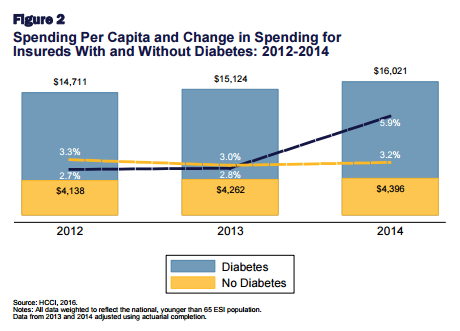Healthcare Spending for Diabetes Patients Rose 6% in 2014
The rise in healthcare spending was associated with an increase in the number of emergency room visits as well as prescription drug use.

- People who have to manage diabetes are in worse shape financially than those without the disease. The Health Care Cost Institute (HCCI) published a study showing that healthcare spending rates among diabetes patients with employer-sponsored health insurance rose about 6 percent in 2014 while those without diabetes experienced a growth of 3.2 percent.

“This report examines the patterns of care for people with diabetes,” HCCI Executive Director David Newman stated in a company press release. “By looking beyond treatment for diabetes we can see what other health issues people with diabetes are facing – such as heart disease – so that the health care system might better address those complex needs.”
The report called the 2014 Diabetes Health Care Cost and Utilization Report discovered that healthcare spending for patients with diabetes averaged $16,021 for each individual in 2014, which grew nearly $900 from the year before. This is more than $10,000 per capita than the costs of covering policyholders without diabetes, the study found.
The rise in healthcare spending was associated with an increase in the number of emergency room visits as well as prescription drug use. Emergency room visits for diabetes patients increased by 8.1 percent while adherence and use of prescription medication grew 8.7 percent from the year 2012 to 2014.
“Understanding how and where we spend healthcare dollars for people with diabetes is the first step in assessing how well the health care system is working and where improvements can be made,” HCCI Senior Researcher Amanda Frost said in a public statement.
Essentially, this study analyzed healthcare spending between adults and children with diabetes in contrast with consumers who do not have diabetes as well as exactly how the funds are spent regarding the treatment of this disease.
The Health Care Cost Institute looked at medical claims representing more than 40 million consumers with employer-sponsored health insurance coverage younger than 65 years of age between the years 2012 to 2014. Out of all these policyholders, 5 percent had type 1 or type 2 diabetes in 2014, the press release states.
The results show that patients who have diabetes had doctor’s appointments or emergency department visits at twice the rate of other policyholders. Additionally, this particular subset of the population took five times as many prescription medications as the group without diabetes.
Another important point to note is that diabetes patients had also pursued healthcare services for cardiovascular problems as well as mental health needs. When looking at young adults with diabetes, the researchers found that these patients were four times as likely to be admitted to a hospital because of mental health or substance abuse reasons. In fact, in 2014, there was a 23.4 percent rise in the number of young adults with diabetes who were hospitalized due to mental health and substance use factors.
“Per capita spending on mental health and substance use admissions was over 4.5 times higher for people with diabetes than for those without diabetes,” the report stated. “Young adults with diabetes had 4 times more mental health and substance use admissions and nearly 3.5 times more ER visits than young adults without diabetes.”
“Young adults (19-25) with diabetes were the only age group to see an increase in service use for all the medical sub-service categories in each study year. Young adults also had more acute hospital admissions per 1,000 people than the other age groups. In 2014, there were 259 acute admissions per 1,000 young adults. Acute admissions rose from 247 admits per 1,000 in 2012 to 259 in 2014, a 5 percent increase.”
The results also show that on an annual basis, diabetes patients spend 2.5 times more on out-of-pocket costs than policyholders without the disease. Those with this medical condition spend nearly $2,000 in out-of-pocket costs every year while consumers without diabetes spend $752.
However, the results also show that, as a diabetes patient’s age increases, their out-of-pocket healthcare spending actually declined. Children had the highest out-of-pocket healthcare spending among all diabetes patients, the Health Care Cost Institute reported.
The results from the study show that health payers would be wise to curb the number of patients who suffer from diabetes. This means that any policyholders who have been diagnosed with prediabetes or are at risk of this disease should be encouraged to transition to a healthier lifestyle.
Patient engagement will become a major topic among health payers attempting to reduce the costs of treating diabetes. Through patient engagement, consumers can be educated to follow a healthy diet, remain committed to a fitness regime, adhere to medication, and reduce their intake of harmful foods.
As both health payers and providers highlight patient engagement, the Triple Aim of Healthcare should be closer to realization with healthcare spending declining and patient health outcomes improving.
Dig Deeper:
Why Patients Need More than Reduced Healthcare Spending
Is Rising US Healthcare Spending Burdening the Economy?

